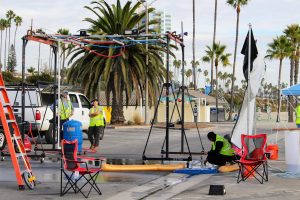SMC studies being used to investigate BMPs’ potential to remove microplastics in runoff

SCCWRP and its partners have initiated a pair of studies exploring the potential of different types of stormwater BMPs to reduce microplastics pollution in runoff – with both studies leveraging ongoing Southern California Stormwater Monitoring Coalition (SMC) investigations examining BMP effectiveness at removing a range of traditional stormwater pollutants.
For both microplastics investigations, researchers are building on the SMC’s original study designs – which are focused on contaminants like sediments, nutrients, trace heavy metals and bacteria – to also evaluate the BMPs’ potential to remove microplastics.
BMPs are stormwater management solutions designed to improve runoff water quality and quantity. Although not expressly designed to remove microplastics, some BMPs are designed to filter and/or retain particulate matter – suggesting their potential to also remove microplastics.
Investigating potential solutions for curbing the spread of microplastics in aquatic environments is a statewide priority for California, which last year released a comprehensive microplastics management strategy to help chart future directions for microplastics research.
During the pair of studies, researchers will measure microplastics removal efficacy for two types of BMPs:
» Structural BMPs – specifically, biofiltration and bioretention systems, which are ubiquitous BMP solutions in Southern California
» Non-structural BMPs – specifically, routine street sweeping, which is a ubiquitous strategy for managing trash and debris on roadways that also may reduce pollution loading to storm drains
Because both microplastics studies are add-ons to existing SMC BMP investigations, the studies are benefitting from cost and resource leveraging.
For the structural BMP microplastics investigation, which was launched in November, researchers are leveraging the SMC’s one-year-old Regional BMP Monitoring Network, a regional monitoring program collecting high-quality, comparable data on how effectively structural BMPs remove a range of common pollutants in runoff.
As part of the BMP monitoring program’s ongoing 2023-2024 wet-weather sampling season, researchers are studying microplastics capture efficacy at up to six bioretention and biofiltration BMP sites across Southern California. The study is working to understand how specific characteristics of different types of BMP engineered media influence the removal of microplastics from runoff.
The study’s partners are California State University, Long Beach and California State University, Los Angeles, which are recruiting a team of university students to help collect samples in the field, as well as measure their microplastics content in the laboratory. The study is aiming to recruit students from underrepresented backgrounds to create unique career development opportunities.
For the non-structural BMP microplastics investigation, which was launched last spring, researchers are leveraging an ongoing SMC study investigating the effectiveness of street sweeping at removing pollution on roadways that would otherwise enter storm drains and contribute to runoff pollution.
The street sweeping study is using a field-deployable rainfall generator custom-built by SCCWRP to quantify street sweeping’s effectiveness in removing multiple types of stormwater contaminants, including microplastics. The microplastics component was added onto the street sweeping study via a collaboration with the City of Santa Barbara.
For more information, contact Dr. Elizabeth Fassman-Beck.
More news related to: Emerging Contaminants, Runoff Water Quality, Southern California Stormwater Monitoring Coalition, Stormwater BMPs, Top News, Trash Pollution